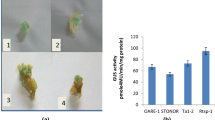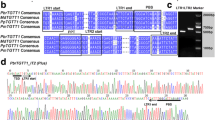Abstract
S1Bn is a plant short interspersed element (SINE) whose amplification probably involves the reverse transcription of an RNA intermediate. In this report, we identified and characterized S1Bn transcripts from different Brassica napus tissues. Despite the presence of a consensus internal POL III promoter in a large number of genomic S1Bn elements, we observed that S1Bn transcripts are rare in B. napus cells. The use of two very sensitive methods (RT-PCR and RACE PCR) allowed the characterization of 102 independent S1Bn cDNA clones from three different tissues (shoot, root and callus). From this analysis, we conclude that the majority of S1Bn transcripts probably result from a small number of cotranscriptional events where an S1Bn element is transcribed due to its presence in a POL II transcriptional unit. Specific POL III RNA transcripts, initiating at the first 5′ nucleotide of the DNA element, are also present in the tested tissues and possibly result from the transcriptional activity of as few as three genomic elements. Two of these transcripts could represent master transcripts responsible for the amplification of S1Bn subfamilies. We also observed that the population of specific POL III transcripts varies among the three tested tissues and that some transcripts appear completely tissue-specific.
Similar content being viewed by others
References
Adeniyi-Jones S, Zasloff M: Transcription processing and nuclear transport of a B1 Alu RNA species complementary to an intron of the murine alpha-fetoprotein gene. Nature 317: 81–84 (1985).
Axelos M, Curie C, Mazzolini L, Lescure B: A protocole for transient gene expression in Arabidopsis thaliana protoplasts isolated from cell suspensions cultures. Plant Physiol Biochem 30: 123–128 (1992).
Britten RJ, Baron WF, Stout DB, Davidson EH: Sources and evolution of human Alu repeated sequences. Proc Natl Acad Sci USA 85: 4770–4774 (1988).
DeChiaria TM, Brosius J: Neural BC1 RNA: cDNA clones reveal nonrepetitive sequence content. Proc Natl Acad Sci USA 84: 2624–2628 (1987).
Deininger PL: SINES: short interspersed repeated DNA elements in higher eucaryotes. In: Berg DE, Howe MM (eds) Mobile DNA, pp. 619–636, American Society of Microbiology, Washington, DC (1989).
Deininger PL, Batzer MA, HutchisonIII CA, Edgell MH: Master genes in mammalian repetitive DNA amplification. Trends Genet 8: 307–311 (1992).
Deragon J-M, Landry BS, Pélissier T, Tutois S, Tourmente S, Picard G: An analysis of retroposition in plants based on a family of SINEs from Brassica napus. J Mol Evol 39: 378–386 (1984).
Doyle JJ, Doyle JL: A rapid DNA isolation procedure for small quantities of fresh tissue. Phytochem Bull 19: 11–15 (1987).
Elder JT, Pan J, Duncan CH, Weissman SM: Transcriptional analysis of interspersed repetitive polymerase III transcription units in human DNA. Nucl Acids Res 9: 1171–1189 (1981).
Endoh H, Nagahashi S, Okada N: A highly repetitive and transcribable sequence in the tortoise genome is probably a retroposon. Eur J Biochem 189: 25–31 (1990).
Frohman MA, Dush MK, Martin GR. Rapid production of full-lenght cDNAs from rare transcripts: amplification using a single gene-specific oligonucleotide primer. Proc Natl Acad Sci USA 85: 8998–9002 (1988).
Geogiev GP, Kramerov DA, Ryskov AP, Skryabin KG, Lukanidin EM: Dispersed repetitive sequences in eukaryotic genomes and their possible biological significance. Cold Spring Harbor Symp Biol 47: 1109–1121 (1983).
Hellmann-Blumberg U, McCarthy-Hintz MF, Gatewood JM, Schmid CW: Developmental differences in methylation of human Alu repeats. Mol Cell Biol 13: 4523–4530 (1993).
Hirzmann J, Luo D, Hahnen J, Hoborm G: Determination of messenger RNA 5′-ends by reverse transcription of the cap structure. Nucl Acids Res 21: 3597-3598.
Hutchinson GB, Andrew SE, McDonald H, Golberg YP, Graham R, Rommens JM, Hayden MR: An Alu element retroposition in the two families with Huntington disease defines a new active Alu subfamily. Nucl Acids Res 21: 3379–3383 (1993).
Kim J, Kass D, Deininger PL: Iranscription and processing of the rodent ID repeat family in germline and somatic cells. Nucl Acids Res 23: 2245–2251 (1995).
Kim J, Martignetti JA, Shen RM, Brosius J, Deininger P: Rodent BC1 RNA gene as a master gene for ID element amplification. Proc Natl Acad Sci USA 91: 3607–3611 (1994).
Kochanek S, Renz D, Doerfler W: DNA methylation in the Alu sequences of diploid and haploid primary human cells. EMBO J 12: 1141–1151 (1993).
Liu W-M, Chu W-M, Choudary PV, Schmid CW: Cell stress and translational inhibitors transiently increase the abundance of mammalian SINE transcripts. Nucl Acids Res 23: 1758–1765 (1995).
Liu W-M, Maraia RJ, Rubin CM, Schmid CW: Alu transcripts: cytoplasmic localisation and regulation by DNA methylation. Nucl Acids Res 22: 1087–1095 (1994)
Liu W-M, Schmid CW: Proposed roles for DNA methylation in Alu transcriptional repression and mutational inactivation. Nucl Acids Res 21: 1351–1359 (1993).
Makalowski W, Mitchell GA, Labuda D: Alu sequences in the coding regions of mRNA: a source of protein variability. Trends Genet 10: 188–193 (1994).
Maraia RJ: The subset of mouse B1 (Alu-equivalent) sequences expressed as small processed cytoplasmic transcripts. Nucl Acids Res 19: 5695–5702 (1991).
Maraia RJ, Driscoll CT, Bilyeu T, Hsu K, Darlington GJ: Multiple dispersed loci produce small cytoplasmic Alu RNA. Mol Cell Biol 13: 4233–4241 (1993).
Marques JP, Gualberto JM, Palme K: Sequence of the Arabidopsis thaliana 7SL RNA gene. Nucl Acids Res 21: 3581 (1993).
Matera AG, Hellmann U, Schmid CW: A transpositionally and transcriptionally competent Alu subfamily. Mol Cell Biol 10: 5424–5432 (1990).
Matsumoto K, Murakami K, Okada N: Gene for lysine tRNA may be a progenitor of the highly repetitive and transcribable sequences present in the salmon genome. Proc Natl Acad Sci USA 83: 3156–3160 (1986).
Mckinnon RD, Danielson P, Brow MAD, Bloom FE, Sutcliffe JG: Expression of small cytoplasmic transcripts of the rat identifier element in vivo and in cultured cells. Mol Cell Biol 7: 2148–2154 (1987).
Mochizuki K, Umeda M, Ohtsubo H, Ohtsubo E: Characterization of a plant SINE, p-SINE1, in rice genome. Jpn J Genet 67: 155–166 (1992).
Nisson PE, Hickey RJ, Boshar MF, Crain WRJr: Identification of a repeated sequence in the genome of the sea urchin which is transcribed by RNA polymerase III and contains the features of a retroposon. Nucl Acids Res 16: 1431–1452 (1988).
Rasmussen M, Rossen L, Giese H: SINE-like properties of a highly repetitive element in the genome of the obligate parasitic fungus Erysiphe graminis f.sp. hordei. Mol Gen Genet 239: 298–303 (1993).
Sambrook J., Fristch EF, Maniatis T: Molecular Cloning: A laboratory Manual. Cold Spring Harbor Laboratory Press, Cold Spring Harbor, NY (1989).
Schmid CW: Human Alu subfamilies and their methylation revealed by blot hybridization. Nucl Acids Res 19: 5613–5617 (1991).
Sinnett D, Richer C, Deragon J-M, Labuda D: Alu RNA transcripts in human embryonal carcinoma cells: model of posttranscriptional selection of master sequences. J Mol Biol 226: 689–707 (1992).
Sutcliffe JG, Milner RJ, Gottesfeld JM, Lerner RA: Identifier sequences are transcribed specifically in brain. Nature 308: 237–241 (1984).
Wallace MR, Andersen LB, Saulino AM, Gregory PE, Glover TW, Collins FS: A de novo Alu insertion results in neurofibromatosis type 1. Nature 353: 864–866 (1991).
Watson JB, Sutcliffe JG: Primate brain-specific cytoplasmic transcript of the Alu repeat family. Mol Cell Biol 7: 3324–3327 (1987).
Wilson ET, Condliffe DP, Sprague KU: Transcriptional properties of BmX, a moderately repetitive silkworm gene that is an RNA polymerase III template. Mol Cell Biol 8: 624–631 (1988).
Yoshioka Y, Matsumoto S, Kojima S, Ohshima K, Okada N, Machida Y: Molecular characterization of a short interspersed repetitive element from tobacco that exhibits sequence homology to specific tRNAs. Proc Natl Acad Sci USA 90: 6562–6566 (1993).
Author information
Authors and Affiliations
Rights and permissions
About this article
Cite this article
Deragon, JM., Gilbert, N., Rouquet, L. et al. A transcriptional analysis of the S1Bn (Brassica napus) family of SINE retroposons. Plant Mol Biol 32, 869–878 (1996). https://doi.org/10.1007/BF00020484
Received:
Accepted:
Issue Date:
DOI: https://doi.org/10.1007/BF00020484




